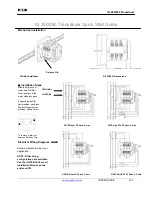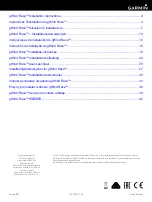
12
MDS TransNET I&O Guide
MDS 05-2708A01, Rev. D
Antenna Selection—Choose an antenna that offers a “DC ground” or direct
low-impedance ground connection for all metallic components. This will
allow static charges on the antenna system to be safely dissipated to ground.
It will also provide a low-impedance discharge path to an earth/safety ground
in the event of a direct lightning strike.
Support Earth/Safety Ground—The structure that supports your antenna
system should have a large-gauge ground wire that goes as directly as
possible to an safety/earth ground system. If a tower is used, it should have
its own ground system. Support structure grounds can be bonded to the elec-
trical system ground for increased protection. Do not use the building’s
AC-power supply ground as a safety ground for lightning protection.
Chassis Ground—Connect a safety/earth ground to the ground post
provided on the electronic/electrical equipment. If a ground terminal is
present, bond the chassis to the safety ground at a point that is as close as
possible to the antenna system and primary power entry points on the chassis.
3.5 How Much Output Power Can be Used?
The transceiver is normally supplied from the factory set for an RF power of
+30 dBm (1 Watt) for 900 MHz and +27 dBm (0.5 Watt) for 2400 MHz; this
is the maximum transmitter output power allowed under FCC rules. The
power must be decreased from this level if the antenna system gain exceeds
6 dBi. The allowable level is dependent on the antenna gain, feedline loss, and
the transmitter output power setting. Power considerations for the transceiver
are discussed below.
NOTE:
In some countries, the maximum allowable RF output may be limited to less than
your model’s peak output. Be sure to check for and comply with the require-
ments for your region.
To determine the maximum allowable power setting of the radio, perform the
following steps:
1. Determine the antenna system gain by subtracting the feedline loss (in
dB) from the antenna gain (in dBi). For example, if the antenna gain is
9.5 dBi, and the feedline loss is 1.5 dB, the antenna system gain would be
8 dB. (If the antenna system gain is 6 dB or less, no power adjustment is
required.)
2. Subtract the antenna system gain from 36 dBm (the maximum allowable
EIRP). The result indicates the maximum transmitter power (in dBm)
allowed under the rules. In the example above, this is 28 dBm.
3. If the maximum transmitter power allowed in your region is less than 30
dBm, use the
PWR
command (described on
Page 38
) to set the power
accordingly.
Содержание TransNET 2400
Страница 94: ...x MDS TransNET I O Guide MDS 05 2708A01 Rev D ...
















































